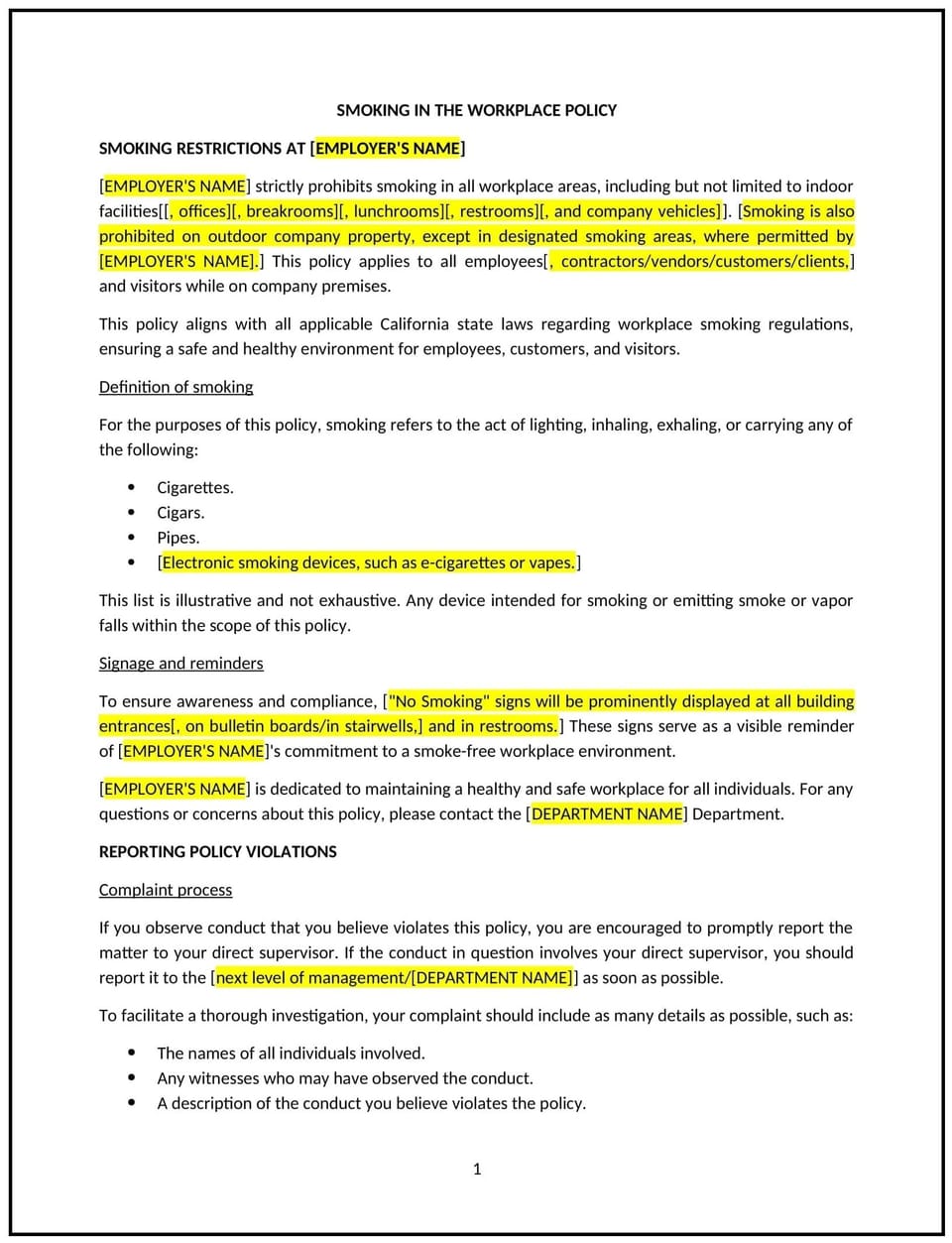Smoking in the workplace policy (California): Free template

Smoking in the workplace policy (California)
In California, a smoking in the workplace policy provides businesses with guidelines to regulate smoking in and around workplace premises. This policy supports compliance with California’s Smoke-Free Workplace Law (Labor Code Section 6404.5) and local ordinances that prohibit smoking in enclosed workplaces and certain outdoor areas.
This policy outlines where smoking is prohibited, the designation of smoking areas (if applicable), and the business’s expectations for employees and visitors. By implementing this policy, California businesses can promote a healthier environment while adhering to state and local regulations.
How to use this smoking in the workplace policy (California)
- Define smoking restrictions: Specify areas where smoking is prohibited, including enclosed spaces, entrances, and other designated zones as required by law.
- Address alternative products: Include provisions for e-cigarettes and vaping devices, as these are treated similarly to traditional smoking under California law.
- Communicate designated smoking areas: If applicable, identify outdoor areas where smoking is allowed and ensure compliance with local ordinances.
- Inform employees and visitors: Clearly display no-smoking signs in prohibited areas and communicate the policy to employees during onboarding or training.
- Enforce the policy: Establish procedures for addressing policy violations, including corrective actions for employees and guidance for handling visitors.
Benefits of using this smoking in the workplace policy (California)
This policy offers several advantages for California businesses:
- Supports compliance: Reflects California’s Smoke-Free Workplace Law and local smoking regulations.
- Promotes health: Creates a healthier and more comfortable work environment for employees and visitors.
- Reduces risks: Minimizes fire hazards and ensures adherence to safety standards in the workplace.
- Enhances professionalism: Demonstrates the business’s commitment to maintaining a safe and respectful workplace.
- Improves morale: Supports employees who prefer a smoke-free environment or are sensitive to smoke.
Tips for using this smoking in the workplace policy (California)
- Reflect California-specific laws: Ensure the policy aligns with state and local regulations on smoking and vaping.
- Train managers: Provide guidance on enforcing the policy respectfully and consistently.
- Use clear signage: Post no-smoking signs in accordance with California law to remind employees and visitors of restrictions.
- Support cessation efforts: Offer resources or information on smoking cessation programs to assist interested employees.
- Review regularly: Update the policy to reflect changes in California smoking laws or workplace conditions.
Q: How does this policy benefit the business?
A: This policy supports compliance with California smoking laws, promotes workplace safety, and creates a healthier environment for employees and visitors.
Q: Where is smoking prohibited under this policy?
A: Smoking is prohibited in enclosed workplace areas, entrances, and any other zones designated as smoke-free by state or local regulations.
Q: How does this policy support compliance with California laws?
A: The policy reflects California’s Smoke-Free Workplace Law and local ordinances, ensuring lawful implementation of smoking restrictions.
Q: What steps should employees take to comply with this policy?
A: Employees should refrain from smoking in prohibited areas and use designated smoking zones, if available, as outlined in the policy.
Q: How can the business handle violations of this policy?
A: The business can address violations through progressive corrective actions, such as verbal warnings, written notices, or other measures detailed in the policy.
This article contains general legal information and does not contain legal advice. Cobrief is not a law firm or a substitute for an attorney or law firm. The law is complex and changes often. For legal advice, please ask a lawyer.


